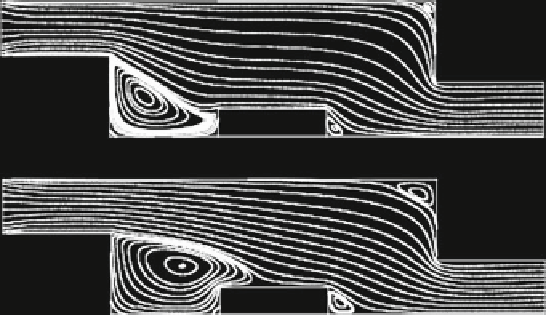Environmental Engineering Reference
In-Depth Information
3 Numerical Solution and Validation of the Results
Numerical simulations were conducted for the laminar flow inside a horizontal open
cavity for Reynolds numbers ranging between 10 and 50. A 2D geometry was used
(see Fig.
1
) and several types of meshes were included in order to obtain independent
results from the numerical parameters. The governing equations were solved with the
finite element method combinedwith the operator splitting schemeGlowinski (
2003
).
This approach was implemented in a numerical code, developed by the authors and
written in Fortran 90. The convergence analysis was done for three different meshes
consisting of 4,850, 14,900 and 18,250 elements. An analysis of the temperature
profiles on the middle horizontal and vertical lines indicates that the largest difference
of the results between the meshes of 4,850 and 14,900 was 8.5%, while the maximum
difference of the results between the meshes of 14,900 and 18,250 was 1.0%. The
analysis was also done for the velocity components, in which cases the worst relative
error between the meshes of 14,900 and 18,250 was less than 1.0%. The simulations
presented in this paper were performed for a cavity with a mesh of 18,250 elements.
The validation of the computer code has been carried out for the double-diffusive
mixed convection in a ventilated cavity by Deng et al. (
2004
). The average Nusselt
number obtained with this code for
Gr
500 was 1.59 which
coincides with the value of (1.61) reported by Deng et al. (
2004
).
=
18,207 and
Re
=
4 Results and Discussions
The results are given in terms of streamlines, isotherms, Nusselt numbers and velocity
profiles, temperature and concentration. Figure
2
shows streamlines for the case of
W
p
=
W
/
5. The top panel shows the behavior of the fluid inside the cavity for
Re
=
10, where three vortices can be observed, the first one is a big, strong and
Fig. 2
Streamlines for
W
p
=
W
/
5.
To p R e
=
10.
Bottom Re
=
50


Search WWH ::

Custom Search